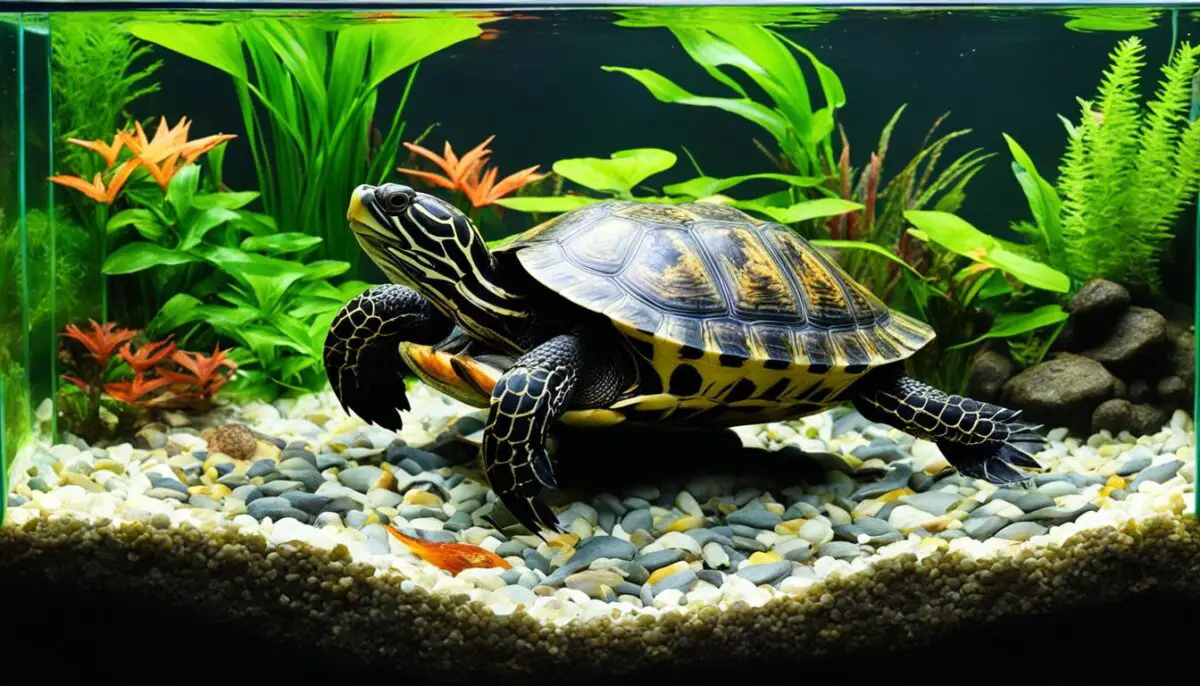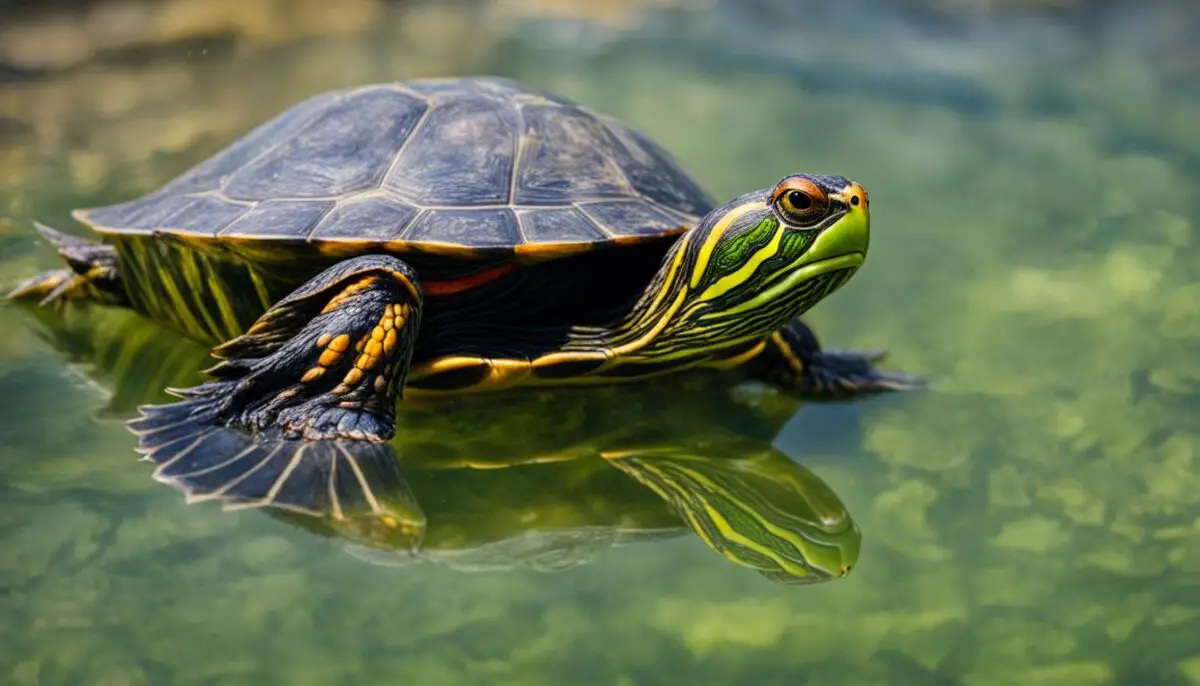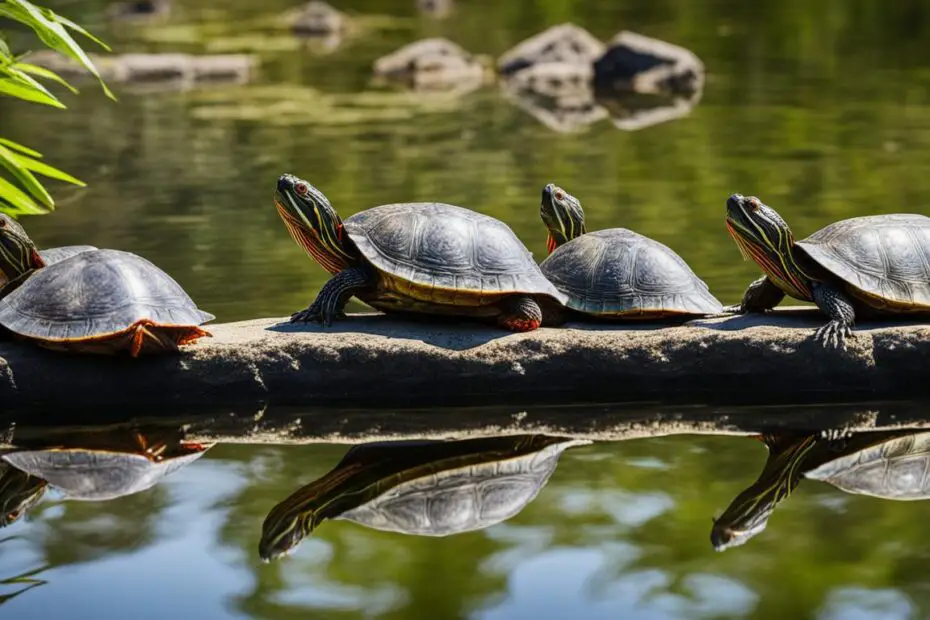Red-eared sliders are fascinating aquatic turtles that captivate many reptile enthusiasts. As adults, they require special care and attention to ensure their health and wellbeing. Understanding the specific needs of red-eared sliders as they mature is crucial in providing them with a thriving environment.
Key Takeaways:
- Adult red eared sliders require unique care to thrive.
- Proper tank setup and habitat conditions are essential.
- A varied diet is important as their dietary needs change with age.
- Regular health monitoring is vital to detect and address any issues.
- Sexing adult red eared sliders can be challenging until sexual maturity.
Creating the Ideal Habitat for Adult Red Eared Sliders
When it comes to caring for adult red-eared sliders, creating an ideal habitat is essential for their health and well-being. These aquatic turtles require spacious tanks with enough room for swimming and basking. While small aquariums may be suitable for young sliders, adults need significantly larger tanks to thrive.
Adult red-eared sliders should be housed in tanks that can hold over 100 gallons of water. This ensures they have enough space to move around and engage in natural behaviors. Providing a spacious environment is crucial for their mental and physical stimulation.
There are various creative housing ideas that can cater to the space requirements of adult red-eared sliders. One option is to use pre-formed plastic pond liners, which are convenient and easy to set up. These liners come in different sizes and can be placed directly in the tank to create a larger water area.
Another option is to set up an outdoor pond for your adult sliders. This allows them to experience more natural sunlight and fresh air, which can have positive effects on their overall health. However, it’s important to ensure the pond has proper fencing and covers to protect the turtles from predators.
“Creating a spacious and stimulating habitat is crucial for the overall well-being of adult red-eared sliders.”
Regardless of the housing setup, maintaining water quality is of utmost importance. Regular water changes, filtration systems, and proper tank maintenance are necessary to keep the habitat clean and healthy for the turtles. Monitoring water parameters such as pH, ammonia, and nitrate levels is essential to prevent any harmful build-up and maintain optimal water conditions.
In addition to an appropriate habitat, adult red-eared sliders require supplemental heat and UVB lighting. These turtles are ectothermic, meaning they rely on external heat sources to regulate their body temperature. A basking area equipped with a heat lamp or ceramic heater is necessary to provide a warm spot for the turtles to thermoregulate. UVB lighting is also essential for their calcium metabolism and shell health.
Ensuring that your adult red-eared slider has the right tank setup and habitat conditions is crucial for their overall well-being and longevity.

| Tank Requirements | Housing Options |
|---|---|
| Minimum 100-gallon tank capacity | Pre-formed plastic pond liners |
| Spacious area for swimming and basking | Outdoor ponds with proper fencing and covers |
| Regular water changes and filtration systems | |
| Supplemental heat and UVB lighting |
Proper Diet and Feeding for Adult Red Eared Sliders
As red-eared sliders mature, their dietary needs undergo a significant change. While they begin as carnivores, their diet gradually shifts to a more herbivorous one. To ensure their health and well-being, it is crucial to provide them with a varied and balanced diet.
The foundation of an adult red-eared slider’s diet should consist of high-quality commercial turtle pellets. These pellets are specifically formulated to meet their nutritional requirements. However, it’s important to supplement their diet with a variety of animal and plant-based foods to ensure they receive all the necessary nutrients.
Animal protein sources such as live or frozen fish, earthworms, and shrimp can be included in their diet. Additionally, feeding them leafy greens, vegetables, and fruits will provide essential vitamins and minerals. Some suitable options include kale, spinach, carrots, bell peppers, and berries.
Feeding the turtles outside of their tank can help maintain cleanliness. This practice prevents the accumulation of leftover food and waste matter in the water, which can lead to poor water quality. It’s essential to provide them with a separate feeding area or use a shallow container to offer food.
It’s essential to avoid overfeeding adult red-eared sliders. Overfeeding can result in obesity, which can lead to various health problems. Additionally, excessive waste matter can compromise the water quality in their tank. A strict feeding schedule should be followed, providing them with an appropriate amount of food based on their size and activity level.
Now let’s take a look at a sample feeding schedule for adult red eared sliders:
| Age | Feedings per Day | Recommended Portion Size |
|---|---|---|
| 1-3 years | Once a day | 2-3 turtle pellets |
| 3-5 years | Once every other day | 3-4 turtle pellets |
| 5+ years | Once every three days | 5-6 turtle pellets |
Remember, this is a general guideline, and individual turtles may have specific dietary needs. It’s always best to consult with a reptile specialist or veterinarian for personalized guidance on feeding your adult red-eared slider.

| Common Health Issues | Symptoms | Prevention/Treatment |
|---|---|---|
| Metabolic Bone Disease (MBD) | Weakened bones, shell deformities | Provide UVB lighting, balanced diet with calcium and vitamin D3 |
| Vitamin A Deficiency | Swollen eyelids, eye discharge, difficulty seeing | Incorporate vitamin A-rich foods in diet |
| Signs of Illness | Open-mouth breathing, sneezing, lethargy, loss of appetite, behavior changes | Consult a reptile veterinarian for diagnosis and treatment |
Identifying the Sex of Adult Red Eared Sliders
Sexing adult red-eared sliders can be challenging until they reach sexual maturity. However, there are some physical characteristics that can help differentiate between males and females.
Males:
Male red-eared sliders have a few key features that distinguish them from females:
- Longer Tail: Adult males typically have a longer tail compared to females.
- Front Claws: Males also have longer front claws as compared to their female counterparts.
Females:
Female red-eared sliders have a different set of physical characteristics:
- Shorter Tail: Adult females generally have a shorter tail compared to males.
- Front Claws: Females have shorter front claws, which are less prominent than those of males.
It’s important to note that accurately sexing red-eared sliders can still be challenging, especially when they are young. Consulting with an experienced reptile veterinarian or herpetologist can provide additional guidance in determining the sex of your adult red-eared slider.
“Accurately sexing red-eared sliders can still be challenging, especially when they are young.”
For those interested in breeding red-eared sliders, it’s crucial to approach breeding responsibly. Breeding should only be undertaken if you have the necessary knowledge, resources, and commitment to properly care for the offspring. Understanding the breeding behaviors and requirements of red-eared sliders is essential.
Additionally, providing a suitable nesting area for egg-laying females is important. Females require a safe and comfortable spot to lay their eggs. Without a proper nest, some females may become egg-bound, a potentially life-threatening condition where they are unable to properly lay their eggs.
| Sex | Tail Length | Front Claw Length |
|---|---|---|
| Male | Longer | Longer |
| Female | Shorter | Shorter |
Conclusion
Caring for red-eared slider adults is a rewarding responsibility that requires dedication and attention to detail. By providing the right care and environment, these fascinating aquatic turtles can live up to 20 years in captivity. Significantly, creating the ideal habitat is crucial to their overall well-being. This includes ensuring they have a spacious tank with ample room for swimming and basking. Maintaining water quality and providing supplemental heat and UVB lighting are also essential factors in keeping them happy and healthy.
Equally important is their diet and feeding regimen. As adult red-eared sliders transition from carnivores to herbivores, a varied diet is essential. Feeding them a combination of commercial turtle pellets, along with a variety of animal and plant-based food items, helps ensure they receive the necessary nutrients for optimal health. Feeding outside of the tank can also help keep their environment clean.
Regular monitoring of their health is vital for identifying and addressing any potential issues. Metabolic bone disease and vitamin A deficiency are common health problems among adult red-eared sliders, often stemming from improper diet or environmental conditions. Providing the right conditions for their natural behaviors, such as basking and swimming, is crucial in preventing such health concerns. A clean and well-maintained habitat further contributes to their overall well-being.
In conclusion, by providing the proper care and attention to their specific needs, adult red-eared sliders can live a long and healthy life. With a suitable habitat, a balanced diet, regular health monitoring, and an understanding of their behavior, you can ensure that these captivating turtles thrive for up to 20 years in captivity. Embracing the commitment of caring for red-eared slider adults yields a fulfilling and rewarding experience for both the caretaker and the turtles themselves.
FAQ
What are the specific care requirements for adult red-eared sliders?
Adult red-eared sliders require spacious habitats with enough room for swimming and basking. They need tanks that can hold over 100 gallons of water, proper lighting, and a balanced diet.
What is the ideal habitat setup for adult red-eared sliders?
Adult red-eared sliders need a tank setup that includes a large, spacious environment with clean water, a basking area, and UVB lighting. Consider using pre-formed plastic pond liners or outdoor ponds to meet their space requirements.
What should I feed my adult red-eared slider?
Adult red-eared sliders require a varied diet that includes commercial turtle pellets, along with a mix of animal and plant-based items. Avoid overfeeding to prevent obesity and excessive waste.
What health issues should I watch out for in adult red-eared sliders?
Adult red-eared sliders can develop health problems such as metabolic bone disease and vitamin A deficiency if not provided with optimal environmental conditions and a balanced diet. Monitor for signs of illness and provide proper care to prevent these issues.
How can I identify the sex of my adult red-eared slider?
Male adult red-eared sliders have longer tails and front claws, while females have shorter front claws and tails. Sexing can be challenging until the turtles reach sexual maturity.
Can adult red-eared sliders breed? What should I do if my female lays eggs?
Adult red-eared sliders can breed, but it’s important to do so responsibly. If your female lays eggs, provide a nesting area to ensure she can lay them safely. Some females may become egg bound if they don’t have a proper nest.

